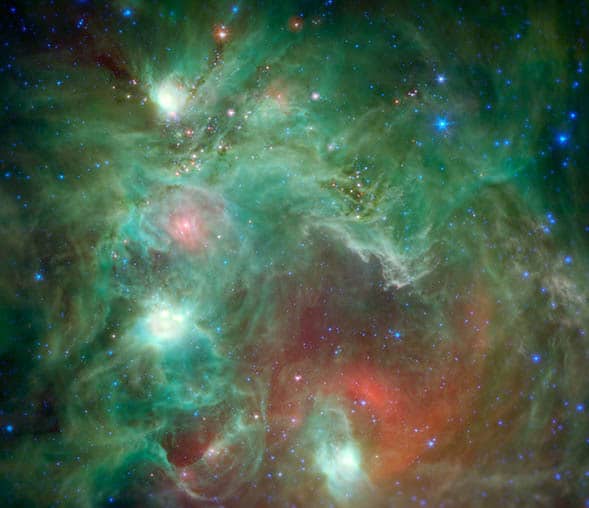Blog
Identifying which type of galaxy UGC 12591 is difficult — featured on the lower left, it has dark dust lanes like a spiral galaxy but a large diffuse bulge of stars like a lenticular. Surprisingly observations show that UGC 12591 spins at about 480 km/sec, almost twice as fast as our Milky Way, and the fastest rotation rate yet measured. The mass needed to hold together a galaxy spinning this fast is several times the mass of our Milky Way Galaxy. Progenitor scenarios for UGC 12591 include slow growth by accreting ambient matter, or rapid growth through a recent galaxy collision or collisions — future observations may tell. The light we see today from UGC 12591 left about 400 million years ago, when trees were first developing on Earth. 400 million ly distance.

David Murray (born February 19, 1955) is an American jazz musician who plays tenor saxophone and bass clarinet mainly. He has recorded prolifically for many record labels since the mid-1970s.
Murray was born in Oakland, California, USA He was initially influenced by free jazz musicians such as Albert Ayler and Archie Shepp. He gradually evolved a more diverse style in his playing and compositions. Murray set himself apart from most tenor players of his generation by not taking John Coltrane as his model, choosing instead to incorporate elements of mainstream players Coleman Hawkins, Ben Webster and Paul Gonsalves into his mature style. Despite this, he recorded a tribute to Coltrane, Octet Plays Trane, in 1999. He played a set with the Grateful Dead at a show on September 22, 1993, at Madison Square Garden in New York City. His 1996 tribute to the Grateful Dead, Dark Star, was also critically well received.
Murray was a founding member of the World Saxophone Quartet with Oliver Lake, Julius Hemphill and Hamiet Bluiett. He has recorded or performed with musicians such as Henry Threadgill, James Blood Ulmer, Olu Dara, Tani Tabbal, Butch Morris, Donal Fox, McCoy Tyner, Elvin Jones, Sunny Murray (no relation), Ed Blackwell, Johnny Dyani, Fred Hopkins, and Steve McCall. David Murray’s use of the circular breathing technique has enabled him to play astonishingly long phrases.
https://www.youtube.com/watch?v=Hxi2uWtiYAI
more...William “Smokey” Robinson Jr. (born February 19, 1940) is an American singer, songwriter, record producer, and former record executive. Robinson was the founder and frontman of the Motown vocal group the Miracles, for which he was also chief songwriter and producer. Robinson led the group from its 1955 origins as “the Five Chimes” until 1972, when he announced a retirement from the group to focus on his role as Motown’s vice president. However, Robinson returned to the music industry as a solo artist the following year. Following the sale of Motown Records in 1988, Robinson left the company in 1990.
Robinson was inducted into the Rock and Roll Hall of Fame in 1987, and was awarded the 2016 Library of Congress Gershwin Prize for his lifetime contributions to popular music.
Smokey Robinson was born to an African-American father and a mother of African-American and French ancestry into a poor family in the North Endarea of Detroit, Michigan, United States. His uncle Claude gave him the nickname “Smokey Joe” when he was a child. He attended Northern High School, where he was above average academically and a keen athlete, though his main interest was music and he formed a doo-wop group named the Five Chimes. At one point, he and Aretha Franklin lived several houses from each other on Belmont; he once said he knew Franklin since she was about five.
https://www.youtube.com/watch?v=6t9wecgyB5g
more...Louis “Kid Shots” Madison (19 February 1899, New Orleans – September 1948, New Orleans) was an American jazz cornetist. Madison was born in New Orleans on 19 February 1899. He studied cornet under David Jones, Louis Dumaine, and Joe Howard. In 1915, he was the drummer in the Colored Waif’s Home band with Louis Armstrong. In 1923, he played second cornet with the Tuxedo Brass Band. During the 1930s, he played with the WPA brass band. In the 1940s, he played with the New Orleans Eureka Brass Band. In January 1948, Madison suffered from a stroke and died eight months later.
more...Jacques de Saint-Luc (baptized 19 September 1616 – ca. 1710) was a Walloon lutenist and composer.
Saint-Luc was born in Ath in 1616; nothing is known about his early years. In 1639 he was invited to become a musician at the court in Brussels, and two years later he had his portrait painted by Gerard Seghers. He moved to Paris in the mid- or late 1640s, but returned to Brussels in October 1647. He evidently spent the next few decades in Brussels, marrying in 1658. An important correspondent of Saint-Luc’s from these years was Constantijn Huygens. In August 1684 Saint-Luc was still living in Brussels, but nothing is known of his whereabouts during the next 16 years: the next mention of him is from 1700, when he visited Berlin on the occasion of the marriage of Prince Frederick of Hesse-Cassel and Princess Louise Dorothea of Prussia. He apparently traveled to Berlin from Vienna, where, according to contemporary sources, he was employed by Prince Eugene of Savoy. Saint-Luc was still alive in 1707 and 1708, when he published some of his compositions in Amsterdam; his date of death is unknown.
The long lifetime of at least 94 years aroused suspicions. And indeed, the booklet to a CD issued in 2018 (by Evangelina Mascardi, http://www.musiqueenwallonie.be/, booklet text obviously not available online) proposes that some of the music attributed to Jacques was in fact composed by his son Laurent (born an baptised in Bruxelles in 1669).
More than 200 pieces by Saint-Luc survive, and show that he was one of the most prominent lutenists of his time. Although he was influenced by French composers (Ennemond Gaultier, Denis Gaultier, Charles Mouton, and others) and adopted their scheme of grouping pieces into suites, he only used the characteristic French style brisé in his preludes.
more...https://www.youtube.com/watch?v=m9mI4zLKPaI
more...Scores of baby stars shrouded by dust are revealed in this infrared image of the star-forming region NGC 2174, as seen by NASAs Spitzer Space Telescope. Some of the clouds in the region resemble the face of a monkey in visible-light images, hence the nebula’s nickname: the “Monkey Head.” However, in infrared images such as this, the monkey disappears. That’s because different clouds are highlighted in infrared and visible-light images.
Found in the northern reaches of the constellation Orion, NGC 2174 is located around 6,400 light-years away. Columns of dust, slightly to the right of center in the image, are being carved out of the dust by radiation and stellar winds from the hottest young stars recently born in the area.
Spitzers infrared view provides us with a preview of the next clusters of stars that will be born in the coming millennia. The reddish spots of light scattered through the darker filaments are infant stars swaddled by blankets of warm dust. The warm dust glows brightly at infrared wavelengths. Eventually, these stars will pop out of their dusty envelopes and their light will carve away at the dust clouds surrounding them.
In this image, infrared wavelengths have been assigned visible colors we see with our eyes. Light with a wavelength of 3.5 microns is shown in blue, 8.0 microns is green, and 24 microns in red. The greens show the organic molecules in the dust clouds, illuminated by starlight. Reds are caused by the thermal radiation emitted from the very hottest areas of dust.
Areas around the edges that were not observed by Spitzer have been filled in using infrared observations from NASAs Wide Field Infrared Survey Explorer, or WISE.

Veronica “Randy” Crawford (born February 18, 1952, Macon, Georgia) is an American jazz and R&B singer. She has been more successful in Europe than in the United States, where she has not entered the Billboard Hot 100 as a solo artist. Her only appearance on the Hot 100 chart was in 1979 as a guest vocalist on The Crusaders‘s top 40 hit “Street Life”. She has had five Top 20 hits in the UK, including her 1980 number 2 hit, “One Day I’ll Fly Away“, as well as six UK Top 10 albums. Despite her American nationality, she won Best British Female Solo Artist in recognition of her popularity in the UK at the 1982 Brit Awards. In the late 2000s she received her first two Grammy Award nominations.
Crawford first performed at club gigs from Cincinnati to Saint-Tropez, but made her name in mid 1970s in New York, where she sang with jazzmen George Benson and Cannonball Adderley. She signed with Columbia Records and released her first single, “Knock On Wood” / “If You Say the Word” in 1972. Adderley invited her to sing on his album, Big Man: The Legend Of John Henry (1975). During a brief tenure at Columbia Records, Crawford recorded “Don’t Get Caught in Love’s Triangle”. She is also one of the vocalists on Fred Wesley & The Horny Horns – A Blow For Me, A Toot To You (1977).
In 1978, Crawford sang vocals on “Hoping Love Will Last”, the opening song on side two of Please Don’t Touch!, which was the second solo album by the former Genesis guitarist Steve Hackett.
She led R&B veterans the Crusaders on the transatlantic hit “Street Life” (1979). A specially re-recorded version was featured in the soundtrack for the films Sharky’s Machine and Jackie Brown, and appeared in commercials in the early 2000s. She later recorded for Warner Bros. Records. Crawford was named the ‘Most Outstanding Performer’ at the 1980 Tokyo Music Festival. Crawford also recorded the love theme (“People Alone”) for the film soundtrack of The Competition on MCA Records in 1980.
https://www.youtube.com/watch?v=z0jCm4gMtVA
more...Buddy Cage (February 18, 1946 – February 5, 2020) was an American pedal steel guitarist, best known as a longtime member of the New Riders of the Purple Sage.
Popular both as a performer and session musician, he played with many bands and recording artists, including Anne Murray, Bob Dylan, Brewer & Shipley, David Bromberg, and the Zen Tricksters.
Buddy Cage learned to play pedal steel guitar at a young age. By the mid-1960s he was working as a professional musician, both onstage and as a session player for the Arc Records label.When the folk music duo of Ian and Sylvia decided to go electric in 1969, he joined their band, known as the Great Speckled Bird. Great Speckled Bird was part of the Festival Express concert tour in 1970. From 1969 to 1972, Cage also recorded four albums with Anne Murray, and one album with Brewer & Shipley.
It was on the Festival Express tour that the New Riders of the Purple Sage became acquainted with Cage. The New Riders were a psychedelic influenced country rock band that had been founded by Jerry Garcia of the Grateful Dead, along with John Dawson and David Nelson. The New Riders and the Dead would perform concerts together, with Garcia playing pedal steel for the New Riders, then playing electric guitar and singing with the Dead.
more...Irma Thomas (born February 18, 1941) is an American singer from New Orleans. She is known as the “Soul Queen of New Orleans”.
Thomas is a contemporary of Aretha Franklin and Etta James, but never experienced their level of commercial success. In 2007, she won the Grammy Award for Best Contemporary Blues Album for After the Rain, her first Grammy in a career spanning over 50 years.
Born Irma Lee, in Ponchatoula, Louisiana, United States, as a teenager she sang with a Baptist church choir. She auditioned for Specialty Recordsat the age of 13. By the time she was 19, she had been married twice and had four children. Keeping her second ex-husband’s surname, she worked as a waitress in New Orleans, occasionally singing with bandleader Tommy Ridgley, who helped her land a record deal with the local Ron label. Her first single, “Don’t Mess with My Man”, was released in late 1959, and reached number 22 on the US Billboard R&B chart.
more...De De Pierce (February 18, 1904 – November 23, 1973) was an American jazz trumpeter and cornetist. He is best remembered for the songs “Peanut Vendor” and “Dippermouth Blues”, both with Billie Pierce.
Pierce was born Joseph De Lacroix Pierce in New Orleans, Louisiana, United States. Pierce’s first gig was with Arnold Dupas in New Orleans in 1924. During his time playing in city nightclubs, he met Billie Pierce, who became his wife as well as a musical companion; the two were the house band at the Luthjens Dance Hall from the 1930s through the 1950s. They released several albums together but stopped performing in the middle of the 1950s due to illness, which left De De Pierce blind. By 1959 they had returned to performing, and De De Pierce toured with Ida Cox and played with the Preservation Hall Jazz Band, before further health problems ended his career. He died in November 1973, at the age of 69.
more...Freedom for Latinos, Muslims, LGBTQ, Handicapped, Homeless, Disenfranchised, First Nation People, African Americans and all humans of planet earth. Remove the Fake Dictator before he removes You!

Abell 2744, nicknamed Pandora’s Cluster, is a giant galaxy cluster resulting from the simultaneous pile-up of at least four separate, smaller galaxy clusters that took place over a span of 350 million years. The galaxies in the cluster make up less than five percent of its mass. The gas (around 20 percent) is so hot that it shines only in X-rays. Dark matter makes up around 75 percent of the cluster’s mass.
This cluster also shows a radio halo along with several other Abell clusters. It has a strong central halo, along with an extended tail, which could either be relic radiation, or an extension of the central halo.
Renato Dupke, a member of the team that discovered the Cluster, explained the origin of the name in an interview: “We nicknamed it ‘Pandora’s Cluster’ because so many different and strange phenomena were unleashed by the collision.”

Jeremy Webster “Fred” Frith (born 17 February 1949) is an English multi-instrumentalist, composer, and improvisor.
Probably best known for his guitar work, Frith first came to attention as one of the founding members of the English avant-rock group Henry Cow. He was also a member of the groups Art Bears, Massacre, and Skeleton Crew. He has collaborated with a number of prominent musicians, including Robert Wyatt, Derek Bailey, the Residents, Lol Coxhill, John Zorn, Brian Eno, Mike Patton, Lars Hollmer, Bill Laswell, Iva Bittová, Jad Fair, Kramer, the ARTE Quartett, and Bob Ostertag. He has also composed several long works, including Traffic Continues (1996, performed 1998 by Frith and Ensemble Modern) and Freedom in Fragments (1993, performed 1999 by Rova Saxophone Quartet). Frith produces most of his own music, and has also produced many albums by other musicians, including Curlew, the Muffins, Etron Fou Leloublan, and Orthotonics.
Frith is the subject of Nicolas Humbert and Werner Penzel’s award-winning 1990 documentary Step Across the Border. He also appears in the Canadian documentary Act of God, which is about the metaphysical effects of being struck by lightning. Frith has contributed to a number of music publications, including New Musical Express and Trouser Press, and has conducted improvising workshops across the world. Frith’s career spans over four decades and he appears on over 400 albums. He still performs actively throughout the world.
Frith was awarded the 2008 Demetrio Stratos Prize for his career achievements in experimental music. The prize was established in 2005 in honour of experimental vocalist Demetrio Stratos, of the Italian group Area, who died in 1979. In 2010 Frith received an honorary doctorate from the University of Huddersfield in West Yorkshire, England in recognition of his contribution to music. Frith was Professor of Composition in the Music Department at Mills College in Oakland, California until his retirement in 2018. He is the brother of Simon Frith, a music critic and sociologist, and Chris Frith, a psychologist at University College London.
more...Noble “Thin Man” Watts (February 17, 1926 – August 24, 2004) was an American blues, jump blues and rhythm and blues saxophonist. He primarily played tenor saxophone. The AllMusicjournalist, Bill Dahl, considered Watts “one of the most incendiary […] fire-breathing tenor sax honkers” of the 1950s.
Born in DeLand, Florida, Watts studied violin and trumpet in his youth, later switching to sax. He gained musical training at Florida A&M, where he played in the school’s marching band with future saxophonist Cannonball Adderley. Hired to play with The Griffin Brothers after college, Watts began his professional career. During the 1950s, he would work with Lionel Hampton, Paul “Hucklebuck” Williams, Dinah Washington, Jerry Lee Lewis, Buddy Holly, Chuck Berry, the Everly Brothers, and others. He also appeared on American Bandstand with Johnny Mathis in 1957,[4]and performed in the house band at a Harlem club owned by boxer Sugar Ray Robinson.
https://www.youtube.com/watch?v=bj0iXWLZJgU
more...More Posts
- John Lamb
- Billy Strayhorn
- World Music with Afion
- Daily Roots with Leroy Sibbles
- Surviving the Pandemic and Realizing Racial Justice
- The Cosmos with NGC 6822
- Diego Rivera
- Randy Newman
- Gato Barbieri
- Gigi Gryce
- Clarence Fountain
- World Music with Modou Touré
- Daily Roots with Lee Scratch Perry
- Surviving the Pandemic and Realizing Racial Justice
- The Cosmos with Arp 54
- Lyle Mays
- Randy Brecker
- Eddie South
- Jimi Hendrix
- Wilbur Morris